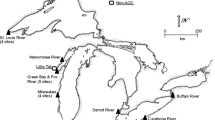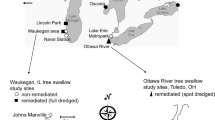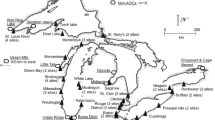Abstract
Exposure to polychlorinated biphenyls (PCBs) in tree swallow (Tachycineta bicolor) eggs on the Sheboygan River, Wisconsin in the 1990s was higher at sites downstream (geometric means = 3.33–8.69 μg/g wet wt.) of the putative PCB source in Sheboygan Falls, Wisconsin than it was above the source (1.24 μg/g) with the exposure declining as the distance downstream of the source increased. A similar pattern of declining exposure was present in the 2010s as well. Although exposure to PCBs in eggs along the Sheboygan River at sites downstream of Sheboygan Falls has declined by ~60 % since the mid-1990s (8.69 down to 3.27 μg/g) there still seems to be residual pockets of contamination that are exposing some individuals (~25 %) to PCB contamination, similar to exposure found in the 1990s. The exposure patterns in eggs and nestlings among sites, and the changes between the two decades, are further validated by accumulation rate information.


Similar content being viewed by others
References
AVMA (2013) AVMA guidelines for the euthanasia of animals, 2013th edn. American Veterinary Medical Association, Schaumburg
Bishop CA, Mahony NA, Trudeau S, Pettit KE (1999) Reproductive success and biochemical effects in tree swallows (Tachycineta bicolor) exposed to chlorinated hydrocarbon contaminants in wetlands of the Great lakes and St. Laurence river basin, USA and Canada. Environ Toxicol Chem 18:263–271
Blancher PJ, McNicol DK (1991) Tree swallow diet in relation to wetland acidity. Can J Zool 69:2629–2637
Burzynski, M (2000) Sheboygan river food chain and sediment contaminant assessment. Final project report U.S. EPA Grant #GL-995681, http://www.epa.gov/glnpo/sediment/FoodChain/index.html
Bzdusek P, Lu J, Christensen ER (2006) PCB congeners and dechlorination in sediments of Sheboygan River, Wisconsin, determined by matrix factorization. Environ Sci Technol 40:120–129
Custer TW, Custer CM, Stromborg KL (1997) Distribution of organochlorine contaminants in double-crested cormorant eggs and sibling embryos. Environ Toxicol Chem 16:1646–1649
Custer CM, Custer TW, Allen PD, Stromborg KL, Melancon MJ (1998) Reproduction and environmental contamination in tree swallows nesting in the Fox River drainage and Green Bay, Wisconsin, USA. Environ Toxicol Chem 17:1765–1987
Custer CM, Custer TW, Coffey M (2000) Organochlorine chemicals in tree swallows nesting in pool 15 of the upper Mississippi River. Bull Environ Contam Toxicol 64:341–346
Custer TW, Custer CM, Hines RK (2002) Dioxins and congener-specific polychlorinated biphenyls in three avian species from the Wisconsin River, Wisconsin. Environ Pollut 119:223–232
Custer CM, Custer TW, Dummer PM, Munney KL (2003) Exposure and effects of chemical contaminants on tree swallows nesting along the Housatonic River, Berkshire County, Massachusetts, USA, 1998–2000. Environ Toxicol Chem 22:1605–1621
Custer CM, Custer TW, Dummer PM (2010a) Patterns of organic contaminants in eggs of an insectivorous, omnivorous, and piscivorous bird nesting on the Hudson River, NY, USA. Environ Toxicol Chem 29:2286–2296
Custer CM, Gray BR, Custer TW (2010b) Effects of egg order on organic and inorganic element concentrations and egg characteristics in tree swallows, Tachycineta bicolor. Environ Toxicol Chem 29:909–921
Custer CM (2011) Swallows as a sentinel species for contaminant exposure and effect studies. In: Elliott JE, Bishop CA, Morrissey CA (eds) Wildlife ecotoxicology: forensic approaches, emerging topics in ecotoxicology, vol 3. Springer, New York, pp 45–91. doi:10.1007/978-0-387-89432-4_3
Custer TW, Dummer PM, Custer CM, Franson JC, Jones M (2014) Contaminant exposure of birds nesting in Green Bay, Wisconsin. Environ Toxicol Chem 33:1832–1839
Harris ML, Elliott JE (2011) Effects of polychlorinated biphenyls, dibenzo-p-dioxins and dibenzofurans, and polybrominated diphenyl ethers in wild birds. In: Beyer WN, Meador JP (eds) Environmental contaminants in biota interpreting tissue concentrations. CRC Press, Boca Raton, pp 477–528
Heinz GH, Swineford DM, Katsma DE (1984) High PCB residues in birds from the Sheboygan River, Wisconsin. Environ Monit Assess 4:155–161
Jayaraman S, Nacci DE, Champlin DM, Pruell RJ, Rocha KJ, Custer CM, Custer TW, Cantwell M (2009) PCBs and DDE in tree swallow (Tachycineta bicolor) eggs and nestlings from an estuarine PCB superfund site, New Bedford Harbor, MA USA. Environ Sci Technol 43:8387–8392
Lu J, Bzdusek PA, Christensen ER, Arora S (2005) Estimating sources of PAHs in sediments of the Sheboygan River, Wisconsin, by a chemical mass balance model. J Great Lakes Res 31:456–465
Maack L, Sonzogni WC (1988) Analysis of polychlorobiphenyl congeners in Wisconsin fish. Arch Environ Contam Toxicol 17:711–719
Mengelkoch JM, Niemi GJ, Regal RR (2004) Diet of the nestling tree swallow. Condor 106:423–429
Quinney TE, Ankney CD (1985) Prey size selection by tree swallows. Auk 102:245–250
Schrank CS, Cormier SM, Blazer VS (1997) Contaminant exposure, biochemical, and histopathological biomarkers in white suckers from contaminated and reference sites in the Sheboygan River, Wisconsin. J Great Lakes Res 23:119–130
Secord AL, McCarty JP, Echols KR, Meadows JC, Gale RW, Tillitt DE (1999) Polychlorinated biphenyls and 2,3,7,8-tetrachlorobidenzo-p-dioxin equivalents in tree swallows from the upper Hudson River, New York state, USA. Environ Toxicol Chem 18:2519–2525
Acknowledgments
We thank River Wildlife, City of Sheboygan, Mayline Co., Sarah and Pete Gahagan,and Richard Seichter for access to their property; Diana Goldberg, Andrew Haertel, Kristina Mott, Kelsey Prestby, Darin Ripp, Josh TeSlaa, and Jocelyn Tschaikovsky for field assistance; Paul M. Dummer for field and data management assistance; David Rogers for assistance with analytical methodology; and L.K. Lohman and two anonymous reviewers for comments on earlier drafts of this manuscript. Use of trade, product, or firm names does not imply endorsement by the U.S. Government.
Conflict of interest
The authors declare that we have no conflict of interest. Data were collected under current laws of the United States of America. The work in 2010–2012 was funded by the Great Lakes Restoration Initiative and was approved by the Animal Care and Use Committee at the Upper Midwest Environmental Sciences Center.
Author information
Authors and Affiliations
Corresponding author
Rights and permissions
About this article
Cite this article
Custer, C.M., Custer, T.W., Strom, S.M. et al. Changes in polychlorinated biphenyl (PCB) exposure in tree swallows (Tachycineta bicolor) nesting along the Sheboygan River, WI, USA. Ecotoxicology 23, 1439–1446 (2014). https://doi.org/10.1007/s10646-014-1286-7
Accepted:
Published:
Issue Date:
DOI: https://doi.org/10.1007/s10646-014-1286-7




